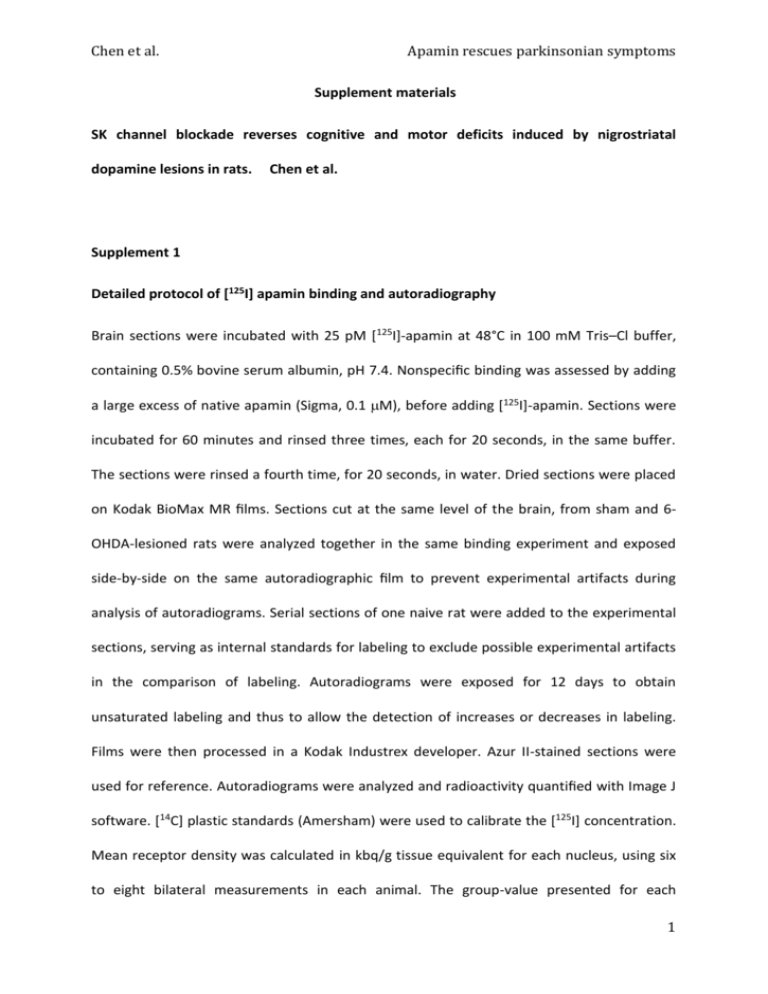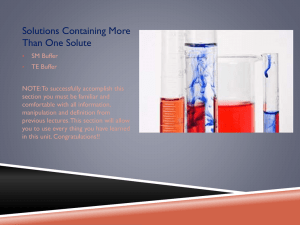Chen et al. Apamin rescues parkinsonian symptoms Supplement
advertisement

Chen et al. Apamin rescues parkinsonian symptoms Supplement materials SK channel blockade reverses cognitive and motor deficits induced by nigrostriatal dopamine lesions in rats. Chen et al. Supplement 1 Detailed protocol of [125I] apamin binding and autoradiography Brain sections were incubated with 25 pM [125I]-apamin at 48°C in 100 mM Tris–Cl buffer, containing 0.5% bovine serum albumin, pH 7.4. Nonspecific binding was assessed by adding a large excess of native apamin (Sigma, 0.1 M), before adding [125I]-apamin. Sections were incubated for 60 minutes and rinsed three times, each for 20 seconds, in the same buffer. The sections were rinsed a fourth time, for 20 seconds, in water. Dried sections were placed on Kodak BioMax MR films. Sections cut at the same level of the brain, from sham and 6OHDA-lesioned rats were analyzed together in the same binding experiment and exposed side-by-side on the same autoradiographic film to prevent experimental artifacts during analysis of autoradiograms. Serial sections of one naive rat were added to the experimental sections, serving as internal standards for labeling to exclude possible experimental artifacts in the comparison of labeling. Autoradiograms were exposed for 12 days to obtain unsaturated labeling and thus to allow the detection of increases or decreases in labeling. Films were then processed in a Kodak Industrex developer. Azur II-stained sections were used for reference. Autoradiograms were analyzed and radioactivity quantified with Image J software. [14C] plastic standards (Amersham) were used to calibrate the [125I] concentration. Mean receptor density was calculated in kbq/g tissue equivalent for each nucleus, using six to eight bilateral measurements in each animal. The group-value presented for each 1 Chen et al. Apamin rescues parkinsonian symptoms structure studied is the mean of values obtained for each animal ± SEM. Nonspecific binding corresponded to around 15% of total binding. Specific binding was calculated as the difference between total and nonspecific binding for a given area. Rat brain regions were identified and named using the Paxinos and Watson’s rat brain atlas (2007). Supplement 2 Technical details of lesion verification - [3H]-Mazindol binding and autoradiography Brain sections were air-dried and were preincubated at 4°C for five minutes in a Tris 50 mM buffer with NaCl 120 mM, KCl 50 mM (pH 7.9). Then, they were incubated for 40 minutes at 4°C with 7 nM [3H]mazindol (specific activity 27 Ci/mmol; PerkinElmer Life and Analytical Sciences, Zaventem, Belgium) in 50 mM Tris buffer containing 300 mM NaCl and 5 mM KCl (pH 7.9), with 3mM desipramine (hydrochloride, Sigma-Aldrich) added to block the norepinephrine reuptake. Sections were rinsed twice for three minutes in the same incubation buffer and then for ten seconds in distilled water before air-drying. Autoradiographs were realized by applying the slides to a Kodak Biomax MR film (SigmaAldrich) for at least six weeks. After exposure, the films were processed in a developer (Kodak GBX developer, Sigma-Aldrich), at room temperature for 30 seconds, then fixed, washed in water and air dried. All autoradiograms were scanned. The surface of striatum was delimitated in pixels with reference to Paxinos and Watson (2007). The extent of bilateral striatal 6-OHDA lesions was estimated by delimitating the extent of the lesioned areas in each hemisphere as the sum of pixels with low gray levels. As no difference was found in either the surface measured on each side of the brain, the values obtained were averaged. The extent of the lesion was determined as the ratio between the lesioned and 2 Chen et al. Apamin rescues parkinsonian symptoms total striatum area, expressed as the percentage of the total striatal surface. Then, a mean ± S.E.M. was calculated for each experimental group. - Tyrosine hydroxylase immunohistochemistry After five minute postfixation in 3% paraformaldehyde and washing [5 x 5 minutes in Tris buffer (50mM)], brain sections were pretreated for quenching of endogeneous peroxidase activity [2 x 10 minutes in Tris buffer (50mM) containing Lysine (18.3 mg/ml) and hydrogen peroxide (0.3%) followed by 6 x 5 minutes in Tris buffer (50mM) washing] and for blocking of non-specific antibody binding [1 x 20 minutes in Tris buffer (50mM) containing bovine serum albumin (5%)(BSA)]. Then they were incubated overnight at 4°C with monoclonal mouse antibody [1:500; Chemicon, Temecula, CA; in Tris buffer containing BSA (1%)], for the detection of TH. After washing [6 x 5 minutes in Tris buffer (50mM)], sections were exposed for 1 hour at room temperature, to biotinylated goat anti-mouse [1:200; Vector Laboratories, Burlingame, CA; in Tris buffer (50mM) containing BSA (1%)] followed by washing [5 x 5 minutes in Tris buffer (50mM)] and by a streptavidin–biotin–horseradish peroxidase solution incubation [Elite ABC Kit, Vector, in Tris buffer (50mM) containing BSA (1%) for 1 hour at room temperature]. Immunolabeling was revealed after washing [3 x 5 minutes in Tris buffer (50mM)] by incubating the sections in a 0.5% solution of diaminobenzidine tetrahydrochloride in Tris buffer containing 3% hydrogen peroxide for 3 minutes at room temperature. Following washing [5 x 5 minutes in Tris buffer (50mM)], sections were dehydrated in an ascending series of alcohols, cleared in xylene, and coverslipped using DPX mounting medium (Sigma-Aldrich). Control staining was performed without the primary or secondary antibodies. Four coronal photomicrographs of the ipsilateral and contralateral SNc and VTA were captured using a Leitz Aristoplan light microscope equipped with a Nikon high-resolution digital camera (756 x 581 pixels; Nikon, 3 Chen et al. Apamin rescues parkinsonian symptoms Tokyo, Japan) interfaced to a PC computer and Image software (Lucia, Nikon), x20). An experimenter, blind to the lesion, quantified TH immunoreactivity (cell body) by counting the total number of TH-positive neurons per section containing the ipsilateral and contralateral SNc and VTA using Image J software. The average of all counts represented the total number of neurons per section. In addition, cell counts were performed on Nissl-stained neurons in the SNc and VTA for detecting neuronal cell bodies in accordance with the Paxinos and Watson’s atlas (2007). Paxinos G and Watson C (2007) The Rat Brain in Stereotaxic Coordinates, Elsevier Academic Press. Amsterdam. 4 Chen et al. Apamin rescues parkinsonian symptoms Supplemental Results: Figures S1 and S2 6-OHDA lesion extent Bilateral intrastriatal 6-OHDA infusions produced lesions restricted to the dorsal striatum sparing the nucleus accumbens (Fig. S1). The loss of [3H]-mazindol labeling extended across the whole rostro-caudal levels of the striatum in 6-OHDA-lesioned subjects. There was no difference in [3H]-mazindol labeling between the three groups injected with apamin 0.0, 0.1 or 0.3 mg/kg in the dorsal striatum (mean decrease: 59% ± 0.02, 54% ± 0.02, 57% ± 0.02, respectively; F2,27=0.803, NS). Unilateral SNc 6-OHDA infusions produced a near-complete depletion (> 90%) of DA in the ipsilateral striatum assessed by the loss of [3H]-mazindol binding in the striatum and to a lesser extent in the nucleus accumbens area (Fig. S1). Supplemental Figures Captions Figure S1. 6-OHDA lesion extent. [3H]-mazindol binding to dopamine uptake sites at the striatum level (here, at + 1.20 mm related to bregma). Examples of [3H]-mazindol binding autoradiography (Top) in a sham (left) and a bilaterally 6-OHDA-lesioned rat (right), (Bottom) in a sham (left) and an unilaterally 6-OHDA-lesioned rat (right). Scale bar: 1 mm. Figure S2. Illustration of the bilateral 6-OHDA lesion and microdialysis probes in the striatum of a representative animal. A: [3H]-mazindol binding autoradiography. The numbers indicate the rostro-caudal coordinates (mm) from bregma (Paxinos and Watson, 2007). B: Cresylviolet stained section showing placements of guide cannula (arrows) in the striatum of the same animal. Bar = 2.5mm. 5 Chen et al. Apamin rescues parkinsonian symptoms Table S1: Locomotor behavior in the different tests The total covered distance (mean ± S.E.M) was measured in cm in each maze. ANOVA, 1 F5,52=0.88, NS; 2 F5,54=0.17, NS; 3 F5,43=0.28, NS. 6 Chen et al. Apamin rescues parkinsonian symptoms Table S2: Variations of apamin binding in DA mesolimbic and nigrostriatal pathways Brain structures Prefrontal cortex Cingulate cortex Accumbens nucleus, core Accumbens nucleus, shell Striatum, dorso-lateral part Striatum, dorso-medial part Septohippocampal nucleus Lateral septal nucleus Medial septal nucleus Basolateral amygdaloid nucleus Central amygdaloid nucleus Medial amygdaloid nucleus CA1 hippocampal field CA3 hippocampal field Dentate Gyrus Entorhinal cortex, ventral part Ventral tegmental area Substantia nigra, pars compacta Apamin binding (%) 100.00 ± 1.43 100.06 ± 0.82 99.98 ± 0.75 101.63 ± 1.12 98.45 ± 1.90 100.92 ± 1.66 99.69 ± 1.41 100.22 ± 1.26 102.14 ± 2.47 99.60 ± 2.58 98.77 ± 3.53 100.16 ± 3.09 100.82 ± 4.48 100.57 ± 1.48 99.10 ± 1.48 102.33 ± 2.70 100.34 ± 3.97 80.47 ± 1.73* Values are the percentage of the apamin binding (relative unit) in 6-OHDA-lesioned rats relative to sham rats. Values are expressed in mean ± S.E.M. *: P<0.05 (6-OHDA vs sham, Student’s test). 7 Chen et al. Apamin rescues parkinsonian symptoms Figure S1 Figure S2 8







